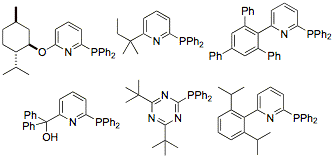C - Concepts for catalysis development
Catalysis research is a process still often dominated by screening approaches and chance findings. It would be desirable to have criteria available allowing one to perform systematic searches.
We use the criteria AMBI-CAT and HOT-CAT to search for new catalytic processes. In a general manner, catalysis development also profits from the development and availability of new classes of ligands.
C-1 - AZARYPHOS ligands for ambifunctional catalysis
The family of AZARYPHOS-ligands (aza-aryl-phosphanes) is suitable for ambifunctional catalysis since their phosphane unit can bind to a metal center, while their nitrogen lone-pair may still interact with the substrate for catalysis.
We have developed a range of syntheses to access this family of ligands (Chem. Eur. J. 2009, 15, 7167).

Ligands for homogeneous catalysis
In the course of work in catalysis development we have prepared several ligands and optimized the synthesis of the imidazolium salts IPr·HCl, IMes·HCl and IXy·HCl, which find many applications in catalysis as precursors of N-heterocyclic carbene ligands (NHC).
Beilstein Journal of Organic Chemistry 2007, 3, 22. (Open Access) “Expedient syntheses of the N-heterocyclic carbene precursor imidazolium salts IPr·HCl, IMes·HCl and IXy·HCl”

C-2 - Homogeneous thermal Catalysis (HOT-CAT)
The term HOT-CAT (homogeneous thermal catalysis) denotes that catalytic reactions or a catalysis screening is performed at temperature levels outside the usual range of homogeneous catalysis (e.g., >200 °C).
If catalytic reactions are performed in a suitable microwave-reactor, such conditions are easily achieved. We want to explore the potential for new reactivity under such conditions, and want to clarify what kind of selectivities can still be achieved.
• catalytic HOT-CAT hydroalkoxylation
• anti-Markovnikov hydration of terminal alkynes in < 15 min